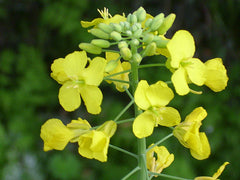Trifolium repens, White Clover
Sow April-August. Sow at 1 grams per sq. m.
The plant makes a good green manure, it is useful for over-wintering, especially in a mixture with Lolium perenne. Produces a good bulk. It is a host to 'clover rot' however, so should not be used too frequently. It can be undersown with cereals or with tomatoes in a greenhouse (sow the seed before planting the tomatoes). Fairly deep rooting but not very fast growing. A good fast ground-cover plant for a sunny position.
A very important food plant for the caterpillars of many butterfly and moth species it is also a good bee plant.
A good companion plant in the lawn, tolerating trampling, but it dislikes growing with henbane or members of the buttercup family. It grows well in an apple orchard, the trees will produce tastier fruit that stores better. It should not be grown with camellias or gooseberries because it harbours a mite that can cause fruit drop in the gooseberries and premature budding in the camellias.
Pre-soak the seed for 12 hours in warm water and then sow in situ.
If the seed is in short supply it might be better to sow it in pots in a cold frame. When they are large enough to handle, prick the seedlings out into individual pots and plant them out in late spring.
Edible uses:
Leaves - raw or cooked as a potherb. The young leaves are harvested before the plant comes into flower and are used in salads, soups etc. They can also be used as a vegetable, cooked like spinach. The leaves are best cooked.
Flowers and seed pods are dried, ground into powder and used as a flour or sprinkled on cooked foods such as boiled rice. Very wholesome and nutritious.
The young flowers can also be used in salads.
Root - cooked.
The dried leaves impart a vanilla flavour to cakes etc.
Dried flowering heads are a tea substitute.


![By Bruce Ackley, The Ohio State University, Bugwood.org [CC BY 3.0 (http://creativecommons.org/licenses/by/3.0)], via Wikimedia Commons](http://www.openpollinated.co.uk/cdn/shop/products/Amaranthus_green_medium.jpg?v=1510586902)


![By Koba-chan (Own work) [GFDL (http://www.gnu.org/copyleft/fdl.html), CC-BY-SA-3.0 (http://creativecommons.org/licenses/by-sa/3.0/), CC BY-SA 2.5 (https://creativecommons.org/licenses/by-sa/2.5) or CC BY 2.5 (http://creativecommons.org/licenses/by/2.5)], via Wikimedia Commons](http://www.openpollinated.co.uk/cdn/shop/products/Fagopyrum_esculentum_flower_jp_medium.jpg?v=1512568112)

![Evelyn Simak [CC BY-SA 2.0 (http://creativecommons.org/licenses/by-sa/2.0)], via Wikimedia Commons](http://www.openpollinated.co.uk/cdn/shop/products/A_crop_of_red_clover_adjacent_to_Mill_Lane_near_The_Carr_-_geograph.org.uk_-_548507_medium.jpg?v=1510586756)
![Photo By User: Carstor (Own work (own picture)) [GFDL (http://www.gnu.org/copyleft/fdl.html), CC-BY-SA-3.0 (http://creativecommons.org/licenses/by-sa/3.0/) or CC-BY-SA-2.5-2.0-1.0 (http://creativecommons.org/licenses/by-sa/2.5-2.0-1.0)], via Wikimedia Commons.](http://www.openpollinated.co.uk/cdn/shop/products/1_2c497e85-b5e9-4bf4-ab29-f2fdc3d9e689_medium.jpeg?v=1510586878)